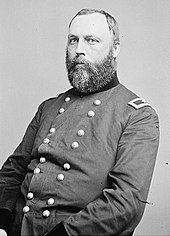William Alexander Hammond
William Alexander Hammond (born August 28, 1828 in Annapolis , Maryland , † January 5, 1900 in Washington, DC ) was an American military doctor , physiologist and neurologist . He is considered the nestor of neurology in the USA.
Hammond studied first in Harrisburg , Pennsylvania , then at the University of the City of New York , where he completed his medical degree with an MD in 1848 at the age of 20 . He first worked in the Philadelphia Hospital before becoming a military doctor in the US Army . Here he took part in several campaigns against Indians. While on vacation (due to illness), Hammond studied military hospitals in Europe. Back in the USA he befriended Silas Weir Mitchell , with whom he worked on poisonous snakes , snake venom and antidotes .
In 1860, Hammond left the military when he was offered the chair of physiology and anatomy at the University of Maryland, Baltimore . When the Civil War broke out, he returned to the army and initially served as a simple military surgeon on General Robert Patterson's staff . Because of his services to the hospital system, Hammond was appointed 11th Surgeon General of the United States Army with the rank of Brigadier General in 1962 at the age of 34 on the recommendation of General George B. McClellan by Abraham Lincoln . Hammond did a great job of caring for the wounded, whose mortality fell dramatically as a result of his organizational measures. He established military hospitals for diseases of the nervous system and founded the Army Medical Museum (now: National Museum of Health and Medicine ) in Silver Spring , Maryland in 1862 .
A protracted conflict with Lincoln's Secretary of War Edwin M. Stanton culminated in 1864 in a case against Hammond for irregularities in the procurement of medical material before a military court that was manipulated in its composition. Hammond was dishonorably discharged from the army in 1864.
Completely penniless, Hammond opened a practice for neurology and psychiatry in New York , which then brought him considerable income. In 1874 he received a professorship in psychiatry and nervous diseases at the University of the City of New York and in 1876 at Bellevue Hospital Medical College (which later became the New York University School of Medicine ).
Since 1859, Hammond was an elected member of the American Philosophical Society . In 1874 he was elected an Associate Fellow to the American Academy of Arts and Sciences . In 1875 he was one of the founders of the American Neurological Association . In addition to the first textbook on neurology in the USA, Hammond also wrote dramas and novels. In 1878 he was rehabilitated by Congress and returned to the army as a retired brigadier general (without salary). From 1888 Hammond lived again in Washington, DC, where he died of a heart condition in early 1900. He is buried in Arlington National Cemetery.
After Hammond's Hammond's disease named, early childhood form of athetosis .
Fonts (selection)
- A treatise on diseases of the nervous system. New York: D. Appleton & Co., 1871.
- A treatise on hygiene: with special reference to the military service. Philadelphia: JB Lippincott & Co., 1863.
- United States Surgeon General's Office: The medical and surgical history of the War of the Rebellion (1861-1865). Washington: Government Printing Office, 1875–1888.
Web links
- William Alexander Hammond at whonamedit.com
- Hammond, William Alexander at Civil War Medical Figures of the University of Alabama at Birmingham (uab.edu)
Individual evidence
- ^ History. In: history.amedd.army.mil. Retrieved November 5, 2017 .
- ^ Member History: William A. Hammond. American Philosophical Society, accessed September 20, 2018 .
- ↑ Book of Members 1780 – present, Chapter H. (PDF; 1.2 MB) In: American Academy of Arts and Sciences (amacad.org). Retrieved November 5, 2017 .
- ^ William Alexander Hammond, Brigadier General, United States Army. In: arlingtoncemetery.net. Retrieved November 6, 2017 .
| personal data | |
|---|---|
| SURNAME | Hammond, William Alexander |
| ALTERNATIVE NAMES | Hammond, William A. |
| BRIEF DESCRIPTION | American military surgeon, physiologist, and neurologist |
| DATE OF BIRTH | August 28, 1828 |
| PLACE OF BIRTH | Annapolis , Maryland |
| DATE OF DEATH | January 5, 1900 |
| Place of death | Washington, DC |

